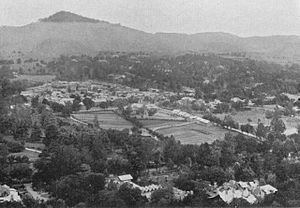Time zone PKT (UTC+5) Number of Tehsils 2 Population 880,666 (1998) | Number of Union Councils 51 Area 1,967 km² | |
 | ||
Colleges and Universities Ayub Medical College Points of interest Mukeshpuri, Miranjani, Sajikot Waterfall, Valley Amusement Park, Ayubia Park Mountain Destinations Abbottabad, Nathia Gali, Havelian, Namli Maira, Dunga Gali | ||
Abbottabad District (Urdu: ضلع ایبٹ آباد) also spelled Abbotabad is in the Khyber Pakhtunkhwa province of Pakistan. The district covers an area of 1,969 km2 with the city of Abbottabad being the principal town. Neighbouring districts are Mansehra to the north, Muzaffarabad to the east, Haripur to the west, and Rawalpindi to the south.
Contents
- Map of Abbottabad District Pakistan
- Origin of name
- Hazara
- Demography
- Parks and protected areas
- Subdivisions
- Election 2008
- Political campaigns
- Provincial assembly
- Education
- References
Map of Abbottabad District, Pakistan
Origin of name
The district is named after Major James Abbott, the first deputy commissioner of Hazara (1849–1853).
In 1822 Ranjit Singh sent a large force under General Amar Singh Majithia, to subdue the troublesome tribes of Hazara, which was defeated by the Karlals, killing Amar Singh.[1] From 1822 to 1845 the Karlal tribe fought many battles with Sikhs and was able to retain its independence throughout the Sikh period.[2] In 1844 Lahore Darbar sent a large force under Diwan Mulraj and Hari Singh to subdue the Karlal country. Taking advantage of the terrain, the Karlals were able to defeat the Sikh army at Nah, killing more than 150 Sikh soldiers. Despite of the Sikh Empire holding parts of lower Hazara, including some Karlal territory, the Karlal tribe paid no tribute to the Sikh Empire and remained Independent.
Hazara
During British rule Abbottabad became the capital of Hazara division, which was named after and contained the Hazara valley, a small valley in the outermost Himalayas, between the Indus in the west and Kashmir in the east.
The current Abbottabad District was originally a tehsil of Hazara, the Imperial Gazetteer of India described it as follows:
Demography
The population counted in 1998 census was 881,000. According to an estimate this had risen to 1.05 million in 2008. according to the old Hazara gazetteers the main tribes here are the Karlal(Sardar), Turks ,Dhund Abbasis, Tanolis, Awans, Jadoons, Qureshi, Mughals, Gujjars, Syeds and Sattis.
According to the 1981 census data for Abbottabad tehsil, 95% of the population have Hindko as their first language, while Punjabi and Urdu account for 1.7% and 0.9% respectively. The local variety of Hindko is Kaghani.
Parks and protected areas
Under the Khyber Pakhtunkhwa Wildlife (Protection, Preservation, Conservation and Management) Act of 1975, two areas have been designated with the district: Ayubia National Park and Qalanderabad game reserve. Both areas cover only 6% of the landed area of the district.
The Ayubia National Park was established in 1984, this park covers an area of over 3,312 ha.
The Qalanderabad game reserve was established in 1980 with an area of 8,940ha.
Subdivisions
Abbottabad district is divided into two tehsils, Abbottabad and Havelian as well as one urban administration area – Nawanshehr. There are fifty-one Union Councils in the district, 35 in Abbottabad tehsil and 16 in Havelian.
Election 2008
With the announcement by the Election commission of Pakistan that elections would be held on 8 January 2008 more than a dozen candidates filed their nomination papers in Abbottabad.
Political campaigns
Abbottabad was the centre of the Sooba Hazara movement that started after national assembly passed 18th amendment to change the name of province from North West Frontier Province (NWFP) to Khyber Pakhtunkhwa. The former governor of the province has been vocal in this opposition to the new name
Provincial assembly
The district is represented in the provincial assembly by five elected MPAs:
Education
According to the Alif Ailaan Pakistan District Education Rankings 2015, Abbottabad is ranked 31 out of 148 districts in terms of education. For facilities and infrastructure, the district is ranked 72 out of 148.
